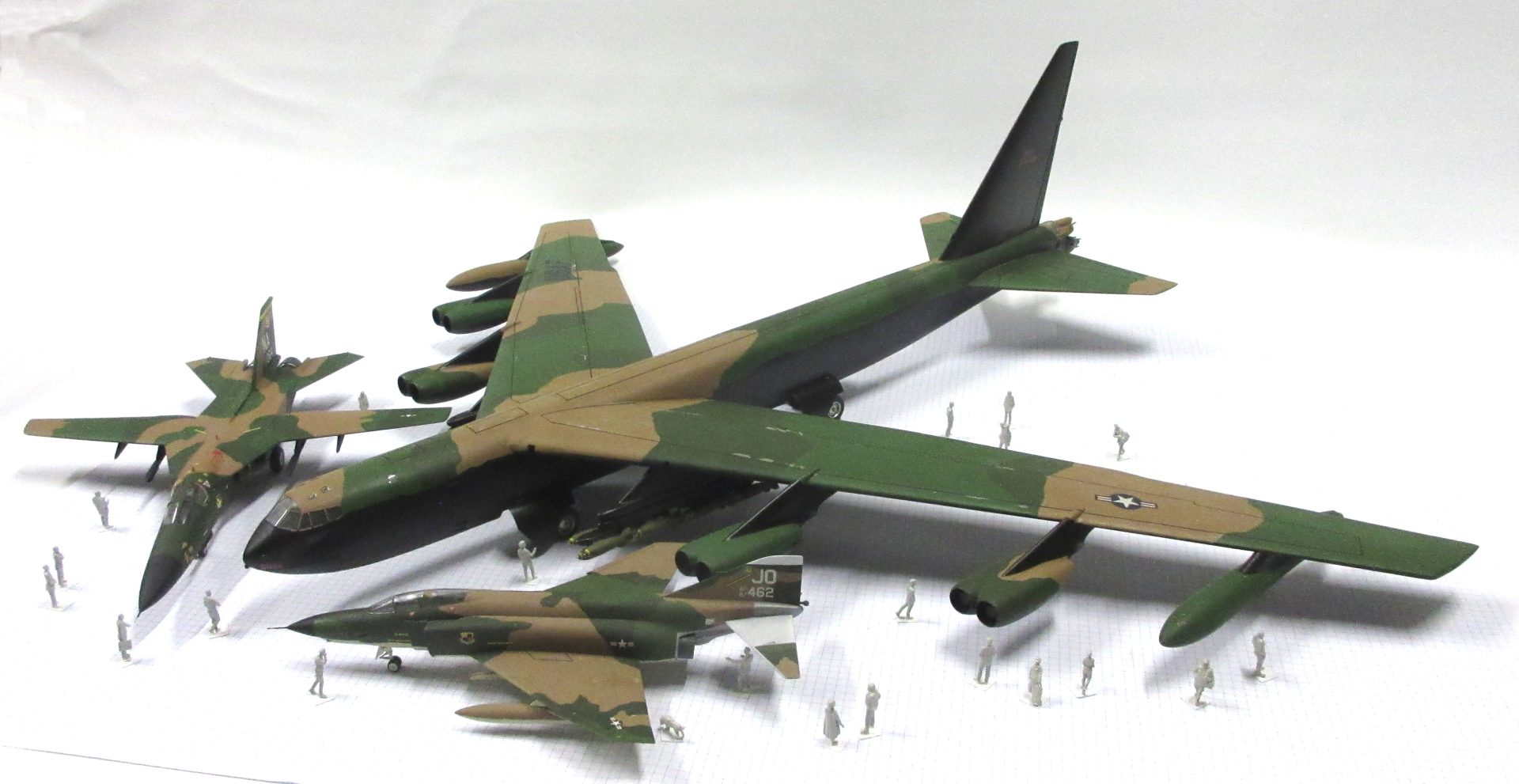South East Asia Camouflage
General Dynamics F-111A – Boeing B-52D – McDonnell RF-4C
 During the Vietnam War the United States Air Force adopted a four tone camouflage scheme for its aircraft operating in that region. The upper colours of two shades of green and one of tan were designed to match the terrain over which the aircraft flew to make it more difficult for North Vietnamese pilots to see. The pattern of the colours was also intended to help break up the way the shape of the aircraft to make them harder to identify and aim at. Here are three aircraft that were painted in that scheme.
During the Vietnam War the United States Air Force adopted a four tone camouflage scheme for its aircraft operating in that region. The upper colours of two shades of green and one of tan were designed to match the terrain over which the aircraft flew to make it more difficult for North Vietnamese pilots to see. The pattern of the colours was also intended to help break up the way the shape of the aircraft to make them harder to identify and aim at. Here are three aircraft that were painted in that scheme.
General Dynamics F-111A in 1/72 by Hasegawa
This aircraft was a variable geometry strike fighter developed in the 1960s. Six of them were test flown over Vietnam in 1968 and larger numbers began flying from Thailand to targets in Vietnam and Cambodia in 1972. They could fly very fast at low altitudes to avoid detection and interception by the North Vietnamese who called them ‘Whispering Death’. They were withdrawn from that theater when the United States ceased flying combat missions in the region. They were still in service and flew operationally during the first Gulf War but the high cost of maintaining them saw them retired in July 1996.
This model was made from the Hasegawa 1/72 kit. There are a few other kits of this aircraft including the Revell kit first published in 1966, the Airfix/MPC kit of 1967 and the Esct/Ertl/AMT/Italeri kit first published in 1988. The Hasegawa kit was first published in 1989 and is, according to the discussion on the Britmodeller forum, definitely the one to get. The in-box review on Modeling Madness concludes: ‘You want the best F-111 kit available in 1/72 (and probably any scale) then this is the one to get.’ It is a bit complex to make because the kit is also the basis for other versions of the F-111 and therefore has its challenges. If you want something a bit easier try the Italeri kit but avoid the Airfix and Revell kits unless you are truly desperate.
Boeing B-52D in 1/72 by Monogram
This aircraft was designed in the late 1940s as a long range strategic bomber and first flew in 1952. It first entered service in 1955 as a nuclear armed deterrent in the early years of the Cold War. It could also carry a very heavy conventional bomb load and was used extensively during the Vietnam war for carpet bombing attacks on North Vietnam. Because of its long range capabilities, the D model B-52 was used more extensively in Vietnam than any other version. Aircraft assigned to Vietnam were painted in the South East Asia camouflage scheme with black bellies to defeat searchlights.
The Monogram kit from which this model was made was first published in 1968 and has since then been reissued several times, most recently by Revell. It is a big sturdy kit which can seem outdated because of a lack of some fine detail and raised panel lines. However, kits from this period of Monogram’s history are still very highly regarded today. The review of this kit on Cybermodeler Online says its positive points are ‘the great detail’ and ‘the best B-52 in any scale’ and its negative points are the raised panel lines and decals. And the build review in Hyperscale says ‘Definitely a challenge at times but still worth making’. The only other kit of a B-52D appears to be a Modelcollect kit first published in 2018. I haven’t seen one but a review of that company’s B-52H version of this aircraft in FineScale Modeler includes a long list of the problems with this kit so their B-52D probably has them too. The high price is also apparently a problem so maybe it’s time to go looking for the Revell kit.
McDonnell RF-4C in 1/72 by Italeri
This aircraft was a reconnaissance version of the famous F-4 Phantom tactical jet fighter. Instead of armament it could be fitted with a variety of cameras in three stations in the nose. They could take high resolution photographs from high or low altitudes. Development began in 1962 and the first one flew in 1964. They began entering service in 1965, were used extensively during the Vietnam war and remained in service with the United States Air Force until 1998.
This model was made from the Italeri kit which was originally published by Esci in 1982 and then by Ertel. I liked it a lot though it does lack some of the detail we’ve come to expect from more modern kits. The long build review on the Modeling Madness website says, in essence, that this is an okay kit for a novice builder because it’s better to get in practice on old cheap kits than newer expensive ones. Your other options are the Fujimi kit which is based on a strike fighter version kit and the Hasegawa kit that has the same parentage. I haven’t seen either, or seen reviews of them, but I like both those kits of straight F-4s so you should do alright with either for this photo reconnaissance version.



